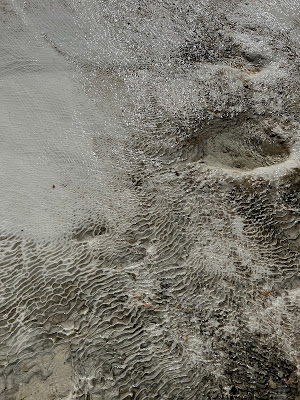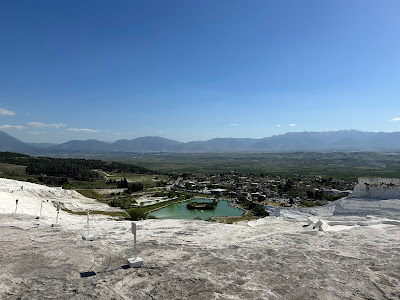The city of Hierapolis (Turkish Name Pammukale, or Cloud Castle) in Central Anatolia has a long history(like almost everything else in Turkey, it seems). A cult center of the Phyrgians from the 7th Century B.C. (a form of which we saw in the museum in Ephesus), the site became known for two things: its mineral baths and as a portal to the Underworld, emanating from a cave from whence toxic gases emerged (The Plutonion, which we will visit tomorrow).
The Greeks arrived here (as they did so many other places), in this case during the Hellenistic Period. Originally founded as a city by Antiochus I (281 - 261 B.C.), the city expanded its status as a polis under the Kingdom of the Pergamon during the reign of Eumenes (197 B.C. to 160 B.C.). The city was known at this period for its Jewish population, which may have been up to 50,000.
As part of the Kingdom of Pergamon, it passed to the Roman Republic in 133 B.C. Unlike other locations (such as Ephesus) it never became fully Romanized, largely remaining Greek in nature.
The hot springs of Hierapolis. Viewed from below, one can perhaps see how the Turkish name "Cloud Castle" came to be.
Earthquakes are a part of much of Turkey, which impacted many of the ruins we saw overall. In Hierapolis, the city was destroyed in A.D. 17 and A.D. 60. The city was rebuilt in the Roman fashion, which is largely reflected in the ruins present today.
The apostle Paul preached in Hierapolis and founded a church. The apostle Philip is traditionally said to have been martyred in here in A.D. 80. Epictetus, one of the great Stoic philosophers, was born here as a slave in A.D. 50.
The city at its height:
The Springs of Hierapolis. One can just take one's shoes off and walk in the water. Interestingly, a recent earthquake cut off the water flow to 50% of the cliffs. To keep them from drying out, a sprinkler system has been built.
Under the Roman Empire, the city reached a population of 100,000. It passed from Roman to Byzantine control, but eventually it was abandoned, devastated first by the Persian Wars of the 7th Century A.D. and then the Seljuk Sultanate in the 11th Century A.D.. It fell to the Crusaders in 1190 A.D and was then retaken from the Crusaders by the Seljuks and a castle built there - which was abandon in the 14th Century A.D. An earthquake in A.D. 1354 finished the job, and the city was abandoned.
Over in the hills yonder are the remains of the city of Laodicea, mentioned in Revelations 3. Like Hierapolis, it was famous as a center for treatment (eye salve, in that case).















Cave= toxic gases= Underworld......small wonder eh? Repeated earthquakes are certainly a death knell for urban centers over the years. An informative post TB.
ReplyDeleteNylon12, it really was fascinating (we get to visit it tomorrow).
DeleteEarthquakes are a repeated feature both in Greece and Turkey (and in the history of the Crusades, in Syria as well). The cities seem to have been rebuilt so long as they were rich and offered value - but at some point it simply became not worth it.
I wonder how long before we start abandoning some of our large coastal cities and leave them to be ruins for future archeologists.
ReplyDeleteHonestly Ed, I would be very surprised. Abandonment of coastal cities is simply not occurring - as you know as well, it is the interior rural towns that are falling into ruin. I suppose that, like my comment to Nylon12 above, at some point it will become not worth rebuilding - but I do not know that coastal dwellers will want to relocate inland. Also, the leaders of those cities will fight that sort of thing tooth and nail due to loss of money and power.
DeleteHonestly, I am shocked we did not abandoned New Orleans after 2005.
You are of course spot on with your observations. I could name a dozen downs that are no longer in the county of my youth and have a list of names and locations that is closer to 100 towns strong. But for some reason, my brain focused on coastal towns because those are the ones I always see abandoned in apocalyptic movies.
DeleteEd - I had not even thought about apocalyptic books and movies, but you are precisely right: seldom are settlements portrayed as being there (which is surprising, as those could be a region of subsistence food and water).
DeleteIt is the same where I grew up: towns have either become suburbs of larger towns or simply faded away into road names and an occasional ruined building.
I really enjoy your mini-lessons in history. Looks like it was an expansive place at one time. Nice location. Oh for a time machine to travel back and see it in its glory.
ReplyDeleteThank you Leigh! I suppose that in another life, I became a historian. I really do enjoy it, and going to such places really brings it alive.
DeleteThis is by far one of the largest sites I have been to - not surprising in terms of size, as it is on a plateau (and so protected) and there is nothing but land all around - it really does have a commanding presence in the area. Olympia and Delphi come to mind as other larger places we have visited. I do wonder that - given when it was built and the relative lack of local enemies (unlike, say Greece), it contributed to the expansiveness.
One can see why such large aggregations of people would bring the Apostles. And I have to admit the more I review my pictures and notes and read the New Testament, how impressed I am at the Apostles. All of these were only reached by ship and by foot.